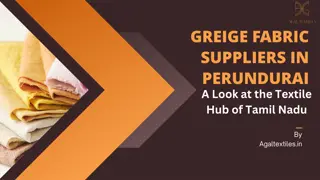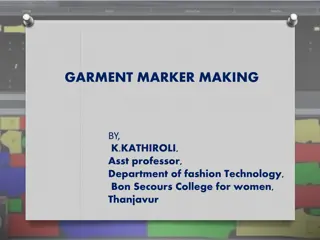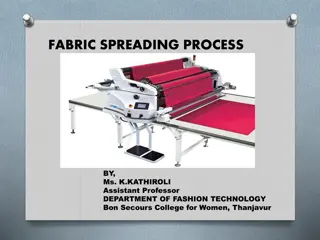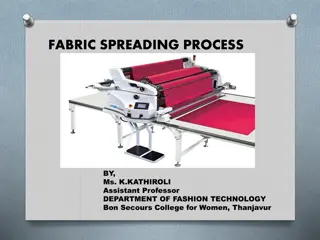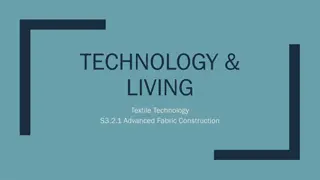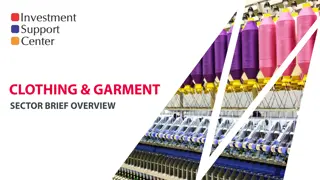Evolution of Fabric Structure and Design in Indian Textile Industry
The power loom sector is pivotal to the Indian Textile Industry, employing millions and contributing significantly to the economy. The development of looms like the Dobby Loom has revolutionized fabric weaving, enabling intricate designs like the Mock Leno weave. Through advanced techniques, such as the Honeycomb weave, Indian textile production continues to innovate, producing a wide range of fabrics for diverse applications.
Download Presentation

Please find below an Image/Link to download the presentation.
The content on the website is provided AS IS for your information and personal use only. It may not be sold, licensed, or shared on other websites without obtaining consent from the author. Download presentation by click this link. If you encounter any issues during the download, it is possible that the publisher has removed the file from their server.
E N D
Presentation Transcript
FABRIC STRUCTURE AND DESIGN P.GRACY ASST.PROFESSER FASHION TECHNOLOGY&COSTUME DESIGN BON SECOURS COLLEGE FOR WOMEN
INTRODUCTION The decentralized power loom sector is the lifeline of Indian Textile Industry. India is having approximately 19.42 lakhs of power looms weaving almost 19,000 million meters of fabric, and provides employment to more than 7 million workers. The industry now produces wide range of fabrics ranging from grey, printed fabric, dyed fabric, cotton fabric, various mix of cotton, synthetic, and other fibres. The powerloom industry has traditionally been a cornerstone of the Indian economy in terms of foreign exchange earnings and employment. Powerlooms contribute around 70 per cent of the total jobs in the textile industry, employing around 6.5 million people. The powerloom industry is equipped with approximately 2.701 million registered looms producing 54,000 square meter fabrics, which are concentrated in clusters across Erode, Salem, Madurai, Ichalkarnaji, Solapur, Bhiwandi, Bhilwara and Malegaon, among others.
DEVELOPMENT OF DOBBY LOOM Loom is a machine for weaving fabric by interlacing a series of vertical, parallel threads (the warp) with a series of horizontal, parallel threads (the filling). The warp yarns from a beam pass through the heddles and reed, and the filling is shot through the shed of warp threads by means of a shuttle or other device and is settled in place by the reed and lay. The woven fabric is then wound on a cloth beam. The primary distinction between different types of looms is the manner of filling insertion. The principal elements of any type of loom are the shedding, picking, and beating-up devices.
In shedding, a path is formed for the filling by raising some warp threads while others are left down. Picking consists essentially of projecting the filling yarn from one side of the loom to the other. Beating-up forces the pick that has just been left in the shed, up to the fell of the fabric. This is accomplished by the reed, which is brought forward with some force by the lay. A woven fabric is produced on a machine called a loom. The start line point for making a fabric is to get the warp beam(10).
DEVELOPMENT OF DESIGN Mock Leno Mock Leno Weaves form open structures with small gap. This Type of weave produces an imitation of leno effect, It is called MOCK LENO weave Mock Leno Design
Honeycomb weave: The honey comb weaves derive their name from their partial resemblance to the hexagonal honey comb cells of wax in which bees store their honey. These weaves form ridges and hollows which give a cell like appearance to the textures. The weaves are of two classes, namely, 1. Ordinary honey comb or honey comb proper 2. Brighton honey comb ORDINARY HONEY COMB WEAVES: These weaves are characterized by the following features Cell like appearance with ridges and hollows Single line crossing a single line or double line crossing a double diagonal line More warp and weft floats Moisture absorbent due to floats Constructed with pointed drafts A reversible fabric having similar effect on both sides
Huckaback huckaback is an absorbent fabric, usually of cotton and in narrow widths ideal for hand towels. It may have a pattern or word (think hotel name) woven into one end. Huckaback weave
Twill Weave Whilst the drafts shown below are suitable for the inexperienced weaver, there is a lot of scope for experimentation. I have shown the drafts in tie up mode. As in the lift plan mode used in my previous article the main section shows the appearance of the weaving. Blue means that the weft is over the warp. The top section shows the order of threading the shafts. The box in the right hand corner shows the lifts that are used and if you are using a floor loom the way that the pedals should be tied up. The dots in the box on the right hand side show which combinations of shafts should be lifted. If you are using a floor loom this will be the pedal that is used but it is straight forward to refer up to the box if you are using a table loom. Twill Weave
Twill weave Twill is a type of textile weave with a pattern of diagonal parallel ribs. It can be identified by looking at the presence of pronounced diagonal lines that run along the width of the fabric. Drafting Design Pegplan
Herringbone Weave This twill are constructed in a different manner from the ordinary zigzag twill. Though it also depend on reversal of twill direction. Here reversal direction occurs after a middle line. Here at first the basic twill is drown then the number of central point is selected in zigzag twill. Drafting Design Pegplan
Pointed Twill Weave As in the lift plan mode used the main section shows the appearance of the weaving. Blue means that the weft is over the warp. The top section shows the order of threading the shafts. The box in the right hand corner shows the lifts that are used and if you are using a floor loom the way that the pedals should be tied up. The dots in the box on the right hand side show which combinations of shafts should be lifted. Pointed Twill Weave
SELECTION OF WEFT YARN SELECTION OF WEFT YARN Linen and jute fabrics are highly versatile, soft and breathable fabrics. Both linen and jute are great sustainable fabrics for your closet as they are biodegradable and sourced from low impact crops. While using these yarns for mats it gives out the natural feel and comfort and also the strength of the both yarn is highly sustainable and it has enough durability.
PROCESS OF FABRICATION PROCESS OF FABRICATION A loom is defined as the average number of shuttles or weft carries inserting weft simultaneously. It is shown that existing power loom must have high phase numbers for their low shuttle velocity. The analyze suggest that looms with high velocity flying shuttles would achieve equally high weft insertion rate with moderate increase in the phase number. The experimental result show that the sized yarn have greater strength, less elongation, low permanent set, and are most uniform in their physical property, and possess better weaving quality then unsized yarns. A simple mills methods for the testing and control of sized yarns, based on the results, is suggested
It can be work out the details about the warp beam is given above, the empty warp bobbins are filled with the warp yarns using a winding machine. The filled bobbins are then mounted on the creel stand. Individual yarns from each bobbin are taken out and led collectively towards the warp beam in the form of planer sheet and a 400 meter long, 200 yarn wide selection of the warp wound on part of the beam. By repeating this 12 times, the warp beam is completely filled and is ready for transfer to the loom. Before doing the is normal industrial practice is to apply size to the warp yarns to impact cohesion to the yarns so that they run smoothly during production Insertion of the weft thread (called as pick) the shed is closed a second shed is formed for the second pick to be inserted by pressing down the treadle.
By alternately pressing down the two treadles A and B, weave is produced. The large number of healds, which are made either from cords or from metallic strips are held in a frame and the total assembly (including the heald shafts) is called harness. For different weave type, the number of harnesses varies considerably, the minimum number beings 2 for weave but can go to a much larger number (a maximum of 40 harnesses is mentioned in the literature Four spools of 20s cotton warp yarns were prepared different percentage of starch. Forty ends from each spool were laid side and tied the center of a warp beam. Before enterting the looms, the yarns passed through the lingoes of a small jacquards harness frame to make sure that each yarn was under the same tension when weaving began. The number of yarns in 40 ends which broke in 4yards.












